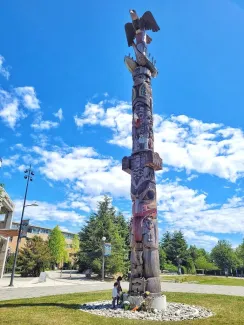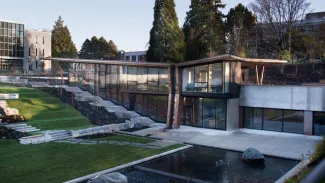
Indigenous History Month
Applied Science is committed to advancing reconciliation and sharing Indigenous ways of knowing through education and training opportunities.
June is National Indigenous History Month! This time is intended to honour, celebrate, and recognize the experiences of Indigenous staff, students, faculty and alumni in APSC, at UBC, and across Canada.

The Decolonization Tour guided by the Belkin Art Gallery highlights site-specific artworks by Indigenous artists and raises questions around issues of place, space and identity. Join the tour on June 12, 2025 from 2:30 -4:30 PM.
Explore the following stories and resources from the different Applied Science disciplines to inspire your learning journey. Feel free to share these stories and links with your colleagues, friends and family.
The UBC School of Nursing's Indigenous Cultural Safety Committee focuses on decolonizing education, reducing barriers for Indigenous students, and creating a psychologically safe environment, while advocating for truth and reconciliation as outlined in the UBC Indigenous Strategic Plan. In 2021, Tania Dick, a member of Dzawada’enuxw First Nations of Kingcome Inlet, was appointed as the inaugural Indigenous Nursing Lead.
Indigenous Cultural Safety Committee UBC Indigenous Strategic Plan

Did you know that the first ever Indigenous architect from UBC, Alfred Waugh (Formline Architecture), designed UBC’s IRSHDC? This two-storey, 6,500 square-foot building reflects the diversity of Indigenous Peoples in Canada and unifies themes of memory and social dialogue through its symbolic architectural elements.
ILANDS (Indigenous Landscape + Architecture Network of Design Students) is an autonomous student group comprised of Indigenous students and alumni from the School of Architecture and Landscape Architecture (SALA) at the University of British Columbia. Their collective purpose is to connect Indigenous students within SALA to support each other. Through various events, activities, and programs, ILANDS aims to foster a strong sense of community while advocating for Indigenous voices in the fields of architecture and landscape architecture.

The Indigenous Community Planning (ICP) program at UBC’s School of Community and Regional Planning (SCARP) focuses on training a new generation of community planners to work in respectful partnership with Indigenous communities. Rooted in the tradition of Indigenous land stewardship and community planning, the ICP program was developed in collaboration with the Musqueam Indian Band.
On April 16, 2024, SCARP held the ICP Practicum final presentations, a highlight of their year, at the Musqueam Cultural Centre. They gathered and heard the findings of ICP students who worked on xʷməθkwəy̓əm (Musqueam), Sḵwx̱wú7mesh (Squamish), and sísqeʔ (Siska) lands.
Commit to creating a community where human rights are respected and equity is embedded in all areas of academic, work and campus life.